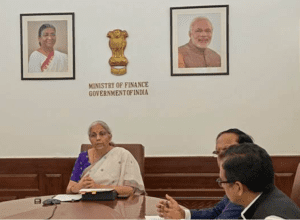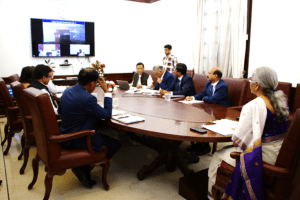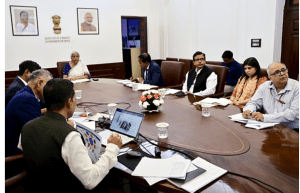New Delhi, 9 May 2025 — In a critical move to bolster national financial resilience during heightened geopolitical uncertainties, Union Minister for Finance and Corporate Affairs, Smt. Nirmala Sitharaman, chaired a high-level meeting today with the top leadership of India’s public and private sector banks and insurance companies. The primary agenda was to assess and reinforce the banking sector’s operational readiness and cybersecurity resilience, especially in the face of potential cyber threats and infrastructural disruptions caused by mounting tensions along India’s border areas.
 Senior officials from the Department of Financial Services (DFS), Reserve Bank of India (RBI), CERT-In, IRDAI, and the National Payments Corporation of India (NPCI) also participated, highlighting the government’s whole-of-system approach to maintaining economic stability during critical situations.
Senior officials from the Department of Financial Services (DFS), Reserve Bank of India (RBI), CERT-In, IRDAI, and the National Payments Corporation of India (NPCI) also participated, highlighting the government’s whole-of-system approach to maintaining economic stability during critical situations.
Strategic Background: Securing the Financial Nerve Centre
India’s financial ecosystem is deeply digitalised and interconnected. With a rapidly growing reliance on platforms like Unified Payments Interface (UPI) and internet banking, especially in rural and semi-urban areas, the need to insulate the system against potential breaches has become imperative. The current geopolitical situation — marked by instability and security threats in the border regions — poses not only a physical challenge but a significant cybersecurity risk as well.


Cybersecurity Preparedness: Infrastructure and Response Protocols
During the session, the Managing Directors and Chief Executive Officers (CEOs) of major banks and insurers presented detailed updates on their cybersecurity frameworks and protocols.
Key cybersecurity initiatives presented included:
-
Implementation of Anti-DDoS Protection: Banks reported the deployment of sophisticated anti-Distributed Denial-of-Service technologies designed to neutralise large-scale, coordinated cyberattacks that could disrupt digital banking platforms.
-
24/7 Security Operations Centres (SOC): These centres are functioning in a heightened alert mode and are fully integrated with national-level cyber monitoring agencies such as CERT-In and the National Critical Information Infrastructure Protection Centre (NCIIPC).
-
Mock Drills and Contingency Planning: Banks have conducted high-level mock drills simulating both cyber and operational crises. These drills tested institutional response times, IT fallback mechanisms, and data recovery systems to ensure business continuity under stress.
-
Phishing Surveillance and Employee Training: Recognising the rising threat of phishing, several banks have launched internal campaigns to enhance employee awareness and vigilance. Real-time phishing detection and prompt action protocols were showcased.
Operational Continuity: Uninterrupted Financial Access- Banking Sector
Smt. Sitharaman placed special emphasis on ensuring uninterrupted access to financial services, especially in regions close to the border where disruptions can be more likely and more harmful.
Key directives included:
-
Maintaining Physical and Digital Banking Services: All banking operations — from cash availability at ATMs to the functioning of UPI and mobile banking — must continue seamlessly. Emergency generators, telecom failovers, and regional redundancy systems must be active and tested.
-
Two Senior Nodal Officers Per Bank: Every bank is to appoint two senior officials at their headquarters — one responsible for cybersecurity escalation and reporting and another for core operational matters. These officers will serve as single points of contact for real-time communication with DFS, CERT-In, and other regulators.
-
Support for Border Area Staff: The Finance Minister expressed serious concern for the safety of bank employees and their families in vulnerable zones. She instructed banks to coordinate actively with local security forces and ensure the physical safety and psychological well-being of employees.
Real-Time Government Coordination and Reporting
To ensure a unified national response, banks were instructed to:
-
Coordinate daily with RBI and CERT-In on potential threats, system health, and cyber incidents.
-
Establish war rooms and escalation protocols in case of national-level breaches or infrastructure failure.
-
Ensure robust audit trails and conduct internal checks to spot anomalies and vulnerabilities.
These directives aim to prevent cascading failures in India’s financial backbone and ensure quick decision-making during potential crises.
Insurance Sector: Commitment to Customer Support


-
Timely Settlement of Claims: Insurers must ensure there are no delays in claim processing, particularly for individuals or businesses affected by any conflict-related developments.
-
Uninterrupted Customer Service: Call centres, branch operations, and online customer service tools must remain active and accessible at all times.
This directive underscores the essential role of the insurance sector in restoring financial confidence and aiding recovery during emergencies.
Support for RRBs and Last-Mile Financial Institutions
Smt. Sitharaman reminded Sponsor Banks of their responsibility to hand-hold Regional Rural Banks (RRBs) and smaller institutions, ensuring that citizens in remote and high-risk areas are not cut off from basic financial services.
This includes providing infrastructure support, deploying mobile banking units where needed, and maintaining cooperative engagement between national banks and local institutions.
Conclusion: A Message of Resilience and National Duty
Smt. Nirmala Sitharaman concluded the meeting by reiterating that the Government of India is fully committed to national security, economic stability, and citizen welfare. She praised the efforts of banking and insurance leaders in fortifying their systems and urged them to remain vigilant, agile, and citizen-focused.
The Finance Minister’s call to action serves as a powerful reminder of the financial sector’s indispensable role in safeguarding India’s economic sovereignty and supporting its people — even amid external disruptions.
Read the full Press release here.
For real time updates, visit Channel 6 Network.

